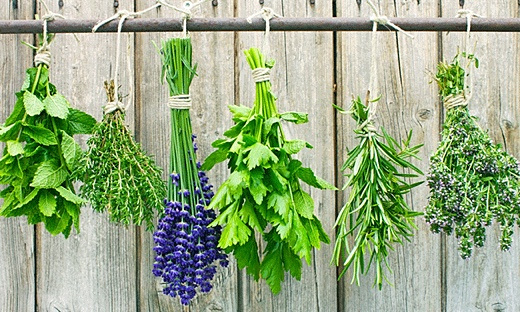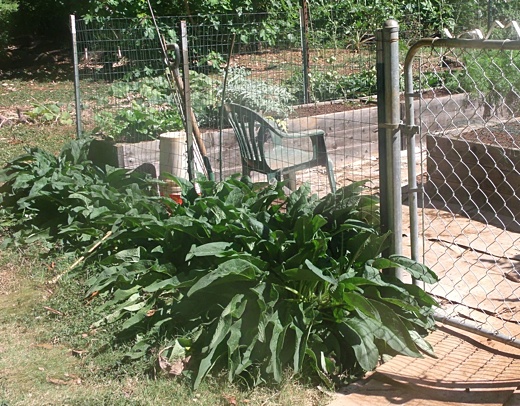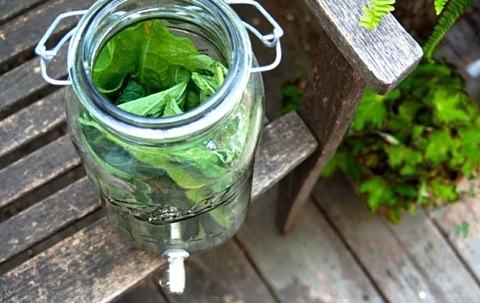SUBHEAD: These herbs aren't just for cooking—here's how you can use them to treat ailments from asthma to anxiety.
By Miles Schneiderman on 3 June 2015 for Yes Magazine -
(http://www.yesmagazine.org/issues/make-it-right/five-medicinal-herbs-you-can-grow-in-your-backyard)

Image above: Five herbs described in original article.
How: Dry and eat the leaves, or brew them fresh in a tea. For all medicinal infusions, make sure to cover the tea with a lid for at least ten minutes before drinking to avoid the evaporation of critical ingredients.
Grow it: Sage is a perennial that thrives in hot, dry climates but will grow in some milder conditions. Plant it in sandy soil in a sunny spot.
Interesting to note: Some studies show sage tea is effective for treating diabetes patients.
How: The best medical use of peppermint comes from extracting the essential oil. Crush the leaves, pack them into a lidded jar, and cover them with vodka. Leave the jar to steep, shaking occasionally; the longer it steeps, the stronger the extract. Strain out the leaves, leaving only the extract behind.
Grow it: Peppermint will grow almost anywhere, but thrives in partial shade and in rich, moist soils.
Interesting to note: Like all mints, the primary active ingredient of peppermint is menthol, which is why peppermint tea is an effective decongestant and expectorant. It can also soothe coughing and sore throats.
How: Dry leaves and mix with honey for eating, or brew in a tea.
Grow it: Catnip is a perennial that prefers rich, well-drained soil or loam and will grow in full sun or partial shade.
Interesting to note: Catnip can also be used as an insect repellant, although Dr. Dazey recommends avoiding it if you are planning to enter forests or jungles populated by large cats.
How: The most effective way of using it as a medicinal herb is brewing it in a tea.
Grow it: Somewhere warm and humid. Rosemary thrives in dry, well-drained soil and fails in extreme cold. In climates with heavy winters, plant it in a container that can be moved indoors.
Interesting to note: The carnosic acid active in rosemary helps protect against cellular and brain damage inflicted by free radicals. This makes it an effective preventative for headaches, memory loss, strokes, and neurological degeneration. Research is being conducted on rosemary's potential use in the treatment of conditions like Alzheimer's and Lou Gehrig's disease.
How: Dice the leaves by hand or in a food processor to use in a poultice. Alternatively, boil the leaves and soak bandages in the strained mixture.
Grow it: Hyssop is a perennial, drought-resistant plant. It grows best in warm, dry climates with well-drained soil and full sun exposure.
Interesting to note: Hyssop has many other medical uses that date back to ancient times, though accounts differ on whether the hyssop we use today is the same plant referenced in the Bible's Psalm 51.
Just One More Herb

Image above: Comfrey growing as a protective border around our raised bed garden. The other half is bordered with lemon grass.
By Miles Schneiderman on 3 June 2015 for Yes Magazine -
(http://www.yesmagazine.org/issues/make-it-right/five-medicinal-herbs-you-can-grow-in-your-backyard)

Image above: Five herbs described in original article.
At its core, most of medicine is still herbology, according to Dr. Jenn Dazey, naturopathic physician at Bastyr University's Department of Botanical Medicine. And growing your own medicinal garden is easier than it might seem. In fact, you might already have one. Many common culinary herbs have a long history as traditional medicines.
1. Common Sage
Salvia officinali
Use it for: Cooling and drying body functions because of its phytosterols. This property makes sage useful in treating high fevers, diarrhea, and excessive sweating or phlegm, as well as throat inflammation, asthma, and bronchitis.
How: Dry and eat the leaves, or brew them fresh in a tea. For all medicinal infusions, make sure to cover the tea with a lid for at least ten minutes before drinking to avoid the evaporation of critical ingredients.
Grow it: Sage is a perennial that thrives in hot, dry climates but will grow in some milder conditions. Plant it in sandy soil in a sunny spot.
Interesting to note: Some studies show sage tea is effective for treating diabetes patients.
2. Peppermint
Mentha piperita
Use it for: Relieving gastrointestinal problems such as irritable bowel syndrome, dyspepsia, colonic spasms, and gastric emptying disorders. Peppermint calms intestinal muscles and improves bile flow.
How: The best medical use of peppermint comes from extracting the essential oil. Crush the leaves, pack them into a lidded jar, and cover them with vodka. Leave the jar to steep, shaking occasionally; the longer it steeps, the stronger the extract. Strain out the leaves, leaving only the extract behind.
Grow it: Peppermint will grow almost anywhere, but thrives in partial shade and in rich, moist soils.
Interesting to note: Like all mints, the primary active ingredient of peppermint is menthol, which is why peppermint tea is an effective decongestant and expectorant. It can also soothe coughing and sore throats.
3. Catnip
Nepeta cataria
How: Dry leaves and mix with honey for eating, or brew in a tea.
Grow it: Catnip is a perennial that prefers rich, well-drained soil or loam and will grow in full sun or partial shade.
Interesting to note: Catnip can also be used as an insect repellant, although Dr. Dazey recommends avoiding it if you are planning to enter forests or jungles populated by large cats.
4. Rosemary
Rosmarinus officinalis
How: The most effective way of using it as a medicinal herb is brewing it in a tea.
Grow it: Somewhere warm and humid. Rosemary thrives in dry, well-drained soil and fails in extreme cold. In climates with heavy winters, plant it in a container that can be moved indoors.
Interesting to note: The carnosic acid active in rosemary helps protect against cellular and brain damage inflicted by free radicals. This makes it an effective preventative for headaches, memory loss, strokes, and neurological degeneration. Research is being conducted on rosemary's potential use in the treatment of conditions like Alzheimer's and Lou Gehrig's disease.
5. Hyssop
Hyssopus officinalis
How: Dice the leaves by hand or in a food processor to use in a poultice. Alternatively, boil the leaves and soak bandages in the strained mixture.
Grow it: Hyssop is a perennial, drought-resistant plant. It grows best in warm, dry climates with well-drained soil and full sun exposure.
Interesting to note: Hyssop has many other medical uses that date back to ancient times, though accounts differ on whether the hyssop we use today is the same plant referenced in the Bible's Psalm 51.
• Miles Schneiderman wrote this article for Make It Right, the Summer 2015 issue of YES! Magazine. Miles is an editorial assistant.
Just One More Herb
By Juan Wilson on 16 June 2015 for Island Breath -
We had a clump of comfrey growing with little tending for almost ten years before we built our raised bed garden. Once we had the fence up around the garden we planted sprigs of the comfrey patch along the outside border. It thrived and became a protective wall keeping out the weeds trees that take hold quickly here. We have found old "Boneknit" to be a useful medicinal herb as well. See (http://www.naturalnews.com/049339_comfrey_organic_gardening_herbal_medicine.html).
Image above: Comfrey growing as a protective border around our raised bed garden. The other half is bordered with lemon grass.
5. Comfrey
Symphjytum

Image above: Comfrey leaves to be made into a tea. From (http://tendcollective.blogspot.com/2011/07/comfrey-tea.html)
Use it for: Comfrey is used as a tea for upset stomach, ulcers, heavy menstrual periods, diarrhea, bloody urine, persistent cough, painful breathing (pleuritis), bronchitis, cancer, and chest pain (angina). It is also used as a gargle for gum disease and sore throat. For details see (http://www.webmd.com/vitamins-supplements/ingredientmono-295-comfrey.aspx?activeingredientid=295&activeingredientname=comfrey)Comfrey is applied to the skin for ulcers, wounds, joint inflammation, bruises, rheumatoid arthritis, swollen veins (phlebitis), gout, and fractures. The chemicals in comfrey might have a healing effect and reduce inflammation when applied to the skin. However, comfrey contains toxic chemicals that can be absorbed through the skin.
Grow it: Comfrey is a perennial, drought-resistant plant. It grows best in warm, dry climates with well-drained soil and full sun exposure. It grows profusely in our garden in Hanapepe Valley. We use it as a border for our raised bed garden. No weeds mess with it as a protective border.
Interesting to note: Some other names for Comfrey are Ass Ear, Black Root, Blackwort, Bruisewort, Gum Plant, Healing Herb, Knitback, Knitbone, Slippery Root, ande, Wallwort..





No comments :
Post a Comment